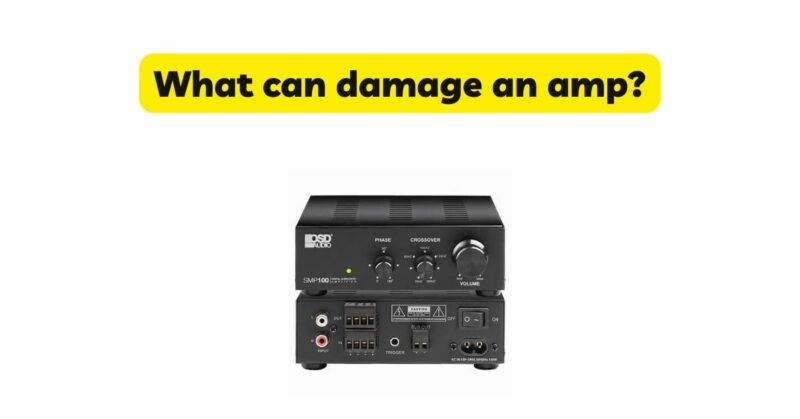Amplifiers are essential components of audio systems, responsible for boosting and enhancing the audio signal. However, they are susceptible to various factors that can potentially damage or compromise their performance. This article aims to explore the common causes of amplifier damage and provide insights into how to protect your amplifier from these risks, ensuring its longevity and optimal functionality.
- Power Overload and Voltage Fluctuations
Power-related issues pose significant risks to amplifiers. The following factors can cause damage:
a. Power Surges: Sudden spikes in electrical voltage, often caused by lightning strikes or power grid fluctuations, can overload the amplifier’s circuitry. Using surge protectors or uninterruptible power supply (UPS) units can safeguard against such surges.
b. Inadequate Power Supply: Insufficient power supply or using an amplifier with a lower power rating than the speakers can strain the amplifier, leading to distortion, overheating, or even component failure. It is crucial to match the amplifier’s power output to the requirements of the speakers.
c. Incorrect Voltage: Plugging an amplifier into an outlet with the wrong voltage can cause irreparable damage. Always check the amplifier’s voltage requirements and ensure proper compatibility.
- Heat and Ventilation Issues
Heat is a natural byproduct of amplifier operation, and inadequate cooling can lead to damage. Factors to consider include:
a. Insufficient Ventilation: Placing the amplifier in an enclosed space or stacking other equipment on top of it can impede airflow, leading to heat buildup. Ensure that the amplifier has sufficient space and clear ventilation pathways.
b. Blocked Air Vents: Amplifiers have cooling fans and vents designed to dissipate heat. Blocking these vents with objects or dust can hinder proper airflow, causing the amplifier to overheat. Regularly clean the vents and ensure they remain unobstructed.
c. High Ambient Temperatures: Operating the amplifier in excessively hot environments can strain its components. Avoid exposing the amplifier to direct sunlight or placing it near heat-emitting devices.
- Improper Speaker Connections
Incorrect speaker connections can result in various problems, potentially damaging the amplifier:
a. Impedance Mismatch: Connecting speakers with impedance levels outside the recommended range can overload the amplifier or reduce its efficiency. Ensure that the speaker impedance matches the amplifier’s specifications.
b. Short Circuits: Improperly connecting speaker wires can cause short circuits, which can damage the amplifier’s output stage. Check the wiring connections, ensuring they are secure and properly insulated.
- Signal Distortion and Clipping
Distorted signals can place excessive strain on the amplifier, leading to potential damage:
a. Clipping: When an amplifier is pushed beyond its limits, it reaches its maximum output capability, resulting in distorted waveform clipping. Continuously driving the amplifier into clipping can damage the speakers and strain the amplifier’s components. Avoid turning the volume levels to extremes or exceeding the amplifier’s rated power output.
b. Poor Signal Quality: Using low-quality audio sources or poorly recorded tracks with excessive noise or distortion can stress the amplifier. Ensure that the audio signals fed into the amplifier are clean and of high quality.
- Mechanical and Environmental Factors
Amplifiers are sensitive electronic devices that can be affected by various mechanical and environmental factors:
a. Physical Damage: Mishandling, dropping, or subjecting the amplifier to physical shocks or impacts can cause internal damage to the delicate components. Handle the amplifier with care and use appropriate protective cases during transportation.
b. Dust and Dirt Accumulation: Dust and dirt can accumulate inside the amplifier, clogging ventilation paths, and leading to overheating. Regularly clean the amplifier using compressed air and a soft cloth to prevent debris buildup.
c. Humidity and Moisture: Exposure to excessive humidity or moisture can cause corrosion and damage the amplifier’s internal circuitry. Keep the amplifier in a dry environment and avoid placing it near water sources.
Conclusion
Understanding the potential risks and factors that can damage an amplifier is crucial for protecting your investment and ensuring optimal performance. By addressing power overload, voltage fluctuations, heat and ventilation issues, improper speaker connections, signal distortion, and considering mechanical and environmental factors, you can significantly reduce the risk of amplifier damage. Regular maintenance, proper handling, and adherence to manufacturer guidelines are key to extending the lifespan of your amplifier and enjoying high-quality audio for years to come.


